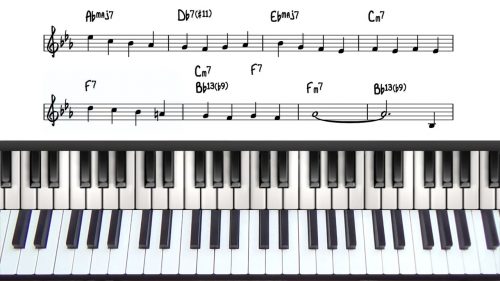Minor 251 Chord Alteration Drills
For practice slot 3 we are going to explore the altered tensions over the minor 251 progression.
When we play a minor 251 progression, the 5th, the 13th, and 9th will usually be altered by moving them either up or down a half step.
In this lesson we’re going to cover some useful voicing formulas and play them around all 12 minor keys.
An Important -11b5 Voicing
For the 2 chord in each minor 251, we’re going to play a -11b5 voicing. This is an extremely useful voicing to memorise in all 12 keys. The formula is root and b5 in the left hand, and then b7, 9, & 11 in the right hand.
Another way to visualise this is root and b5 in the left hand and major triad built from the b7 in he right hand. We have 4 drills for each key and we use this voicing as our starting point for each drill.
The V7 Chord: b9#5 & #5#9 Variations
For the 1st drill we move from the ii-7b5 chord to the V7 chord with #5 and b9 alterations.
For the second drill we play #5#9 over the V7 chord. So this time that top note of the triad moves up a minor 3rd interval.
Emphasising The Altered Tones
For the 3rd drill, we are going to toggle between the altered tones. When playing over minor 251s, those 3 altered tones, the #5, the b9, and the #9 are 3 of the most ‘colourful’ tones we could play, and so this exercise gets us familiar with their sound and colour.
For the final drill we are going to add a descending altered line into our right hand. You will hear this melodic line in countless solos and improvisations. It’s a beautiful way to bring out that altered sound in our right hand and helps us to visualise those 3 altered notes over any V7 chord.
Lesson Downloads
-
Upper Structure Triad Cheat Sheet File Type: pdf
-
Altered Harmony Practice Planner File Type: pdf
Practice Tips
-
As a priority, learn and memorise the ii-11b5 voicing in all 12 keys.
-
The ii-11b5 voicing is an extremely versatile voicing in both a comping setting and a solo piano context.
-
Notice the different colour created by having the b9 on top of the voicing, and having the #9 on top. Each brings out a different 'colour' and 'texture' to the voicing.
- Toggling between the alterations is a nice way to add both rhythmic and harmonic support when there is space for us to fill in as the accompanist.







